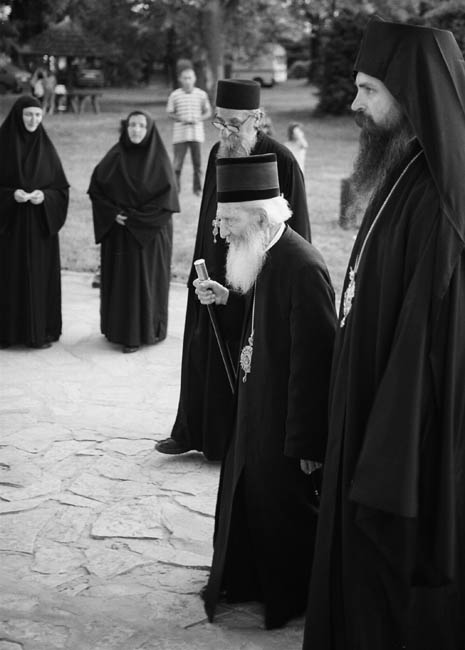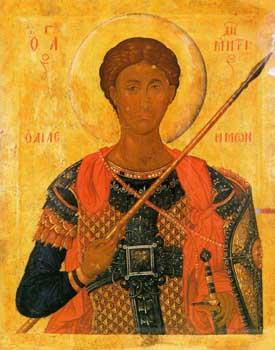|
Matejče Monastery
The Monastery of the Most Holy Mother of God ( sr, Манастир Пресвете Богородице, Macedonian: Жеглиговски манастир), commonly known as Matejče (Матејче) or Matejić (Матејић), is a 14th-century Orthodox monastery located in the village of Matejče on the slopes of Skopska Crna Gora, near Skopje and Kumanovo. The village is inhabited by 89% Muslim Albanians and 10% Orthodox Serbs (2002 census). The monastery was built in the 14th century on the ruins of an older, Byzantine Greek church built in 1057–59, as evidenced by preserved Greek inscriptions. It was mentioned for the first time in 1300 in a chrysobull of the Serbian king Stefan Milutin (r. 1282–1321). In the mid-14th century, the Serbian emperor Stefan Dušan (r. 1331–55) started reconstructing the monastery, finished by his son Stefan Uroš V in 1357 (thus becoming his endowment). Coins of Uros V has been found at the site. Isaiah the Serb and Vladislav Grama ... [...More Info...] [...Related Items...] OR: [Wikipedia] [Google] [Baidu] |
Serbian Orthodox
The Serbian Orthodox Church ( sr-Cyrl, Српска православна црква, Srpska pravoslavna crkva) is one of the autocephalous (ecclesiastically independent) Eastern Orthodox Christian churches. The majority of the population in Serbia, Montenegro and the Republika Srpska entity of Bosnia and Herzegovina are members of the Serbian Orthodox Church. It is organized into metropolitanates and eparchies, located primarily in Serbia, Bosnia and Herzegovina, Montenegro, and Croatia. Other congregations are located in the Serb diaspora. The Serbian Patriarch serves as first among equals in his church. The current patriarch is Porfirije, enthroned on 19 February 2021. The Church achieved autocephalous status in 1219, under the leadership of Saint Sava, becoming the independent Archbishopric of Žiča. Its status was elevated to that of a patriarchate in 1346, and was known afterwards as the Serbian Patriarchate of Peć. This patriarchate was abolished by the Ottoman Em ... [...More Info...] [...Related Items...] OR: [Wikipedia] [Google] [Baidu] |
Vladislav Gramatik
Vladislav the Grammarian (Bulgarian and sr, Владислав Граматик; 1456–79) was a Bulgarian Orthodox Christian monk, scribe, historian and theologian active in medieval Bulgaria and Serbia, regarded as part of both the Bulgarian and Serbian literary corpus. His collections of manuscripts constitute a compendium of translations and original Bulgarian and Serbian texts produced between the 13th and 15th centuries. His texts have been ordered chronologically, starting with the ''1465 Collection'' followed by the ''Zagreb Collection'' (1469), the ''Adrianti Collection'' (1473), the ''Rila Panegyric'' (1479) and two other collections of texts compiled in the 1470s and 1480s respectively. Personal life Vladislav was born ca. 1420 in the village of Novo Brdo (in present-day Kosovo), in the Serbian Despotate. Novo Brdo fell to the Ottomans in 1455, and the Despotate fell by 1459. Historians assert that he received his education in the school of Constantine of Kostenets. In ... [...More Info...] [...Related Items...] OR: [Wikipedia] [Google] [Baidu] |
Eastern Orthodox Monasteries In North Macedonia
Eastern may refer to: Transportation *China Eastern Airlines, a current Chinese airline based in Shanghai *Eastern Air, former name of Zambia Skyways *Eastern Air Lines, a defunct American airline that operated from 1926 to 1991 *Eastern Air Lines (2015), an American airline that began operations in 2015 *Eastern Airlines, LLC, previously Dynamic International Airways, a U.S. airline founded in 2010 *Eastern Airways, an English/British regional airline *Eastern Provincial Airways, a defunct Canadian airline that operated from 1949 to 1986 *Eastern Railway (other), various railroads *Eastern Avenue (other), various roads *Eastern Parkway (other), various parkways *Eastern Freeway, Melbourne, Australia *Eastern Freeway Mumbai, Mumbai, India *, a cargo liner in service 1946-65 Education *Eastern University (other) *Eastern College (other) Other uses * Eastern Broadcasting Limited, former name of Maritime Broadcasting System, Canada * ... [...More Info...] [...Related Items...] OR: [Wikipedia] [Google] [Baidu] |
Medieval Serbian Orthodox Monasteries
In the history of Europe, the Middle Ages or medieval period lasted approximately from the late 5th to the late 15th centuries, similar to the post-classical period of global history. It began with the fall of the Western Roman Empire and transitioned into the Renaissance and the Age of Discovery. The Middle Ages is the middle period of the three traditional divisions of Western history: classical antiquity, the medieval period, and the modern history, modern period. The medieval period is itself subdivided into the Early Middle Ages, Early, High Middle Ages, High, and Late Middle Ages. Population decline, counterurbanisation, the collapse of centralized authority, invasions, and mass migrations of tribes, which had begun in late antiquity, continued into the Early Middle Ages. The large-scale movements of the Migration Period, including various Germanic peoples, formed new kingdoms in what remained of the Western Roman Empire. In the 7th century, North Africa and the Mi ... [...More Info...] [...Related Items...] OR: [Wikipedia] [Google] [Baidu] |
2001 Insurgency In Macedonia
The 2001 insurgency in Macedonia was an armed conflict which began when the ethnic Albanian National Liberation Army (NLA) militant group, formed from veterans of the Kosovo War and Insurgency in the Preševo Valley, attacked Macedonian security forces at the beginning of February 2001, and ended with the Ohrid Agreement, signed on 13 August of that same year. There were also claims that the NLA ultimately wished to see Albanian-majority areas secede from the country, though high-ranking members of the group have denied this. The conflict lasted throughout most of the year, although overall casualties remained limited to several dozen individuals on either side, according to sources from both sides of the conflict. With it, the Yugoslav Wars had reached Macedonia. The Socialist Republic of Macedonia had achieved peaceful independence from Yugoslavia in 1991. Background When it declared its independence from Yugoslavia on 8 September 1991, Macedonia was the only ex- Yugoslav r ... [...More Info...] [...Related Items...] OR: [Wikipedia] [Google] [Baidu] |
Fresco Paintings In North Macedonia
Fresco (plural ''frescos'' or ''frescoes'') is a technique of mural painting executed upon freshly laid ("wet") lime plaster. Water is used as the vehicle for the dry-powder pigment to merge with the plaster, and with the setting of the plaster, the painting becomes an integral part of the wall. The word ''fresco'' ( it, affresco) is derived from the Italian adjective ''fresco'' meaning "fresh", and may thus be contrasted with fresco-secco or secco mural painting techniques, which are applied to dried plaster, to supplement painting in fresco. The fresco technique has been employed since antiquity and is closely associated with Italian Renaissance painting. The word ''fresco'' is commonly and inaccurately used in English to refer to any wall painting regardless of the plaster technology or binding medium. This, in part, contributes to a misconception that the most geographically and temporally common wall painting technology was the painting into wet lime plaster. Even in appare ... [...More Info...] [...Related Items...] OR: [Wikipedia] [Google] [Baidu] |
Serbian Patriarch Pavle
Pavle ( sr-cyr, Павле, ''Paul''; 11 September 1914 – 15 November 2009) was the patriarch of the Serbian Orthodox Church from 1990 to his death. His full title was ''His Holiness the Archbishop of Peć, Metropolitan of Belgrade and Karlovci, and Serbian Patriarch Pavle''. Before his death, he was the oldest living leader of an Eastern Orthodox church. Because of poor health, he spent his last years in the Military Medical Academy in Belgrade, while his duties were carried out by Metropolitan Amfilohije. Early life Pavle was born as Gojko Stojčević (Гојко Стојчевић) in the village of Kućanci near Magadenovac, then part of Austria-Hungary (present-day Croatia). He lost both of his parents in childhood, and was raised by an aunt. After finishing elementary school, Pavle graduated from a gymnasium in Belgrade, then studied at the seminary in Sarajevo. After finished Seminary, Gojko entered University of Belgrade where he studied Theology and Medicine ... [...More Info...] [...Related Items...] OR: [Wikipedia] [Google] [Baidu] |
Insurgency In The Republic Of Macedonia
The 2001 insurgency in Macedonia was an armed conflict which began when the ethnic Albanian National Liberation Army (NLA) militant group, formed from veterans of the Kosovo War and Insurgency in the Preševo Valley, attacked Macedonian security forces at the beginning of February 2001, and ended with the Ohrid Agreement, signed on 13 August of that same year. There were also claims that the NLA ultimately wished to see Albanian-majority areas secede from the country, though high-ranking members of the group have denied this. The conflict lasted throughout most of the year, although overall casualties remained limited to several dozen individuals on either side, according to sources from both sides of the conflict. With it, the Yugoslav Wars had reached Macedonia. The Socialist Republic of Macedonia had achieved peaceful independence from Yugoslavia in 1991. Background When it declared its independence from Yugoslavia on 8 September 1991, Macedonia was the only ex- Yugoslav ... [...More Info...] [...Related Items...] OR: [Wikipedia] [Google] [Baidu] |
Hilandar
The Hilandar Monastery ( sr-cyr, Манастир Хиландар, Manastir Hilandar, , el, Μονή Χιλανδαρίου) is one of the twenty Eastern Orthodox monasteries in Mount Athos in Greece and the only Serbian monastery there. It was founded in 1198 by Stefan Nemanja (Saint Symeon) and his son Saint Sava. St. Symeon was the former Grand Prince of Serbia (1166-1196) who upon relinquishing his throne took monastic vows and became an ordinary monk. He joined his son Saint Sava who was already in Mount Athos and who later became the first Archbishop of Serbia. Upon its foundation, the monastery became a focal point of the Serbian religious and cultural life, as well as assumed the role of "the first Serbian university". It is ranked fourth in the Athonite hierarchy of 20 sovereign monasteries. The ''Mother of God through her Icon of the Three Hands'' (Trojeručica), is considered the monastery's abbess. Etymology The etymological meaning of "Hilandar" is probably deriv ... [...More Info...] [...Related Items...] OR: [Wikipedia] [Google] [Baidu] |
Banja Monastery
The Banja Monastery ( sr, Манастир Бања, Manastir Banja) is a Serbian Orthodox Monastery located near Priboj, Serbia. Monastery Banja presents Cultural Monument of Exceptional Importance in Serbia. History Time of founding of the monastery is unknown, but the first historical sources (Studenica Typicon) mention it in the 12th century. In 1220 Banja became center of Serbian Orthodox Eparchy of Dabar. There are three churches within the monastery, the Church of St. Nicholas, of St. Eliah and the Church of Ascension of the Holy Virgin. St. Nicholas Church, the main monastery church, was founded by King Stefan Dečanski (r. 1322–31) in 1329. The original church was burned during the Ottoman invasion. Itzkowitz, Norman (1980). Ottoman Empire and Islamic tradition. University of Chicago Press The church was restored in 1570 and gained its present look in 1904 when the last restoration took place. The monastery was not only center of the bishopric but the mausoleum of ... [...More Info...] [...Related Items...] OR: [Wikipedia] [Google] [Baidu] |
Marko's Monastery
Marko's Monastery ( Macedonian and sr, Марков Манастир) is a monastery located in the village of Markova Sušica, from central Skopje in North Macedonia. The monastery bears the name of Serbian Prince Marko who reigned at the time of its completion. Marko's Monastery has been active since its establishment. Description Marko's Monastery contains a single cross-shaped church dedicated to Saint Demetrius. The monastery grounds also consist of lodgings, a belfry, a well, warehouses, a bakery, and a mill. The monastery still operates a special oven used to make rakija. The church has a narthex, a central dome and a smaller dome on the western side. It was built of bricks and stone. The iconstasis is made of stone pillars. The frescoes inside the church were done by a number of painters from the region. The Holy Mother of God, the twelve great feasts, Jesus Christ, and Saint Nicholas are some of the subjects depicted in the frescoes. History Construction of the Ch ... [...More Info...] [...Related Items...] OR: [Wikipedia] [Google] [Baidu] |


.jpg)



.jpg)
